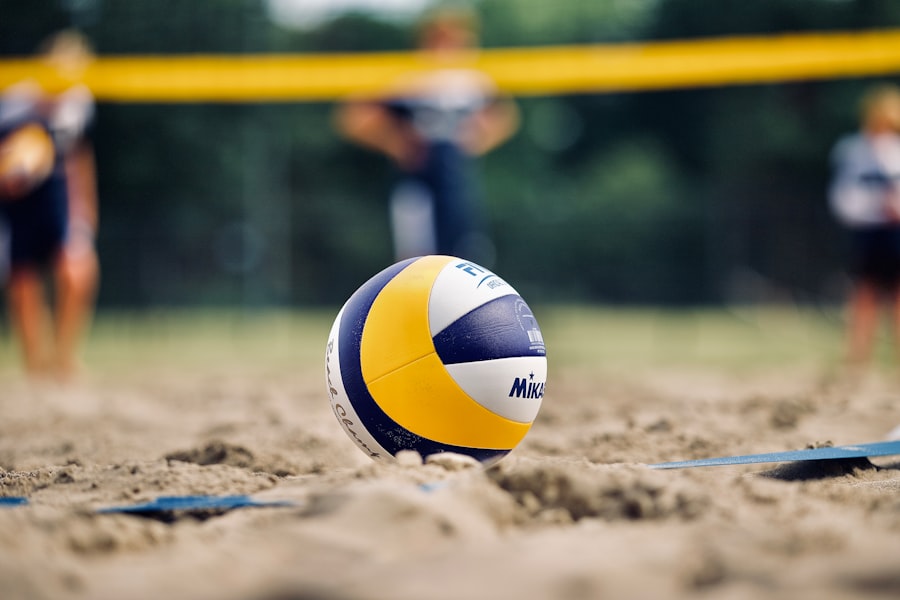Download links
How to install Mastering Volleyball: Tips for Improving Your Game APK?
1. Tap the downloaded Mastering Volleyball: Tips for Improving Your Game APK file.
2. Touch install.
3. Follow the steps on the screen.
Description
Volleyball is a dynamic sport that combines elements of strategy, athleticism, and teamwork. At its core, the game is played between two teams, each consisting of six players, who aim to score points by sending a ball over a net and into the opposing team’s court. The fundamental objective is to prevent the ball from touching the ground on one’s own side while attempting to make it land on the opponent’s side.
The game is played in sets, with teams needing to reach a predetermined number of points, typically 25, to win a set, and the first team to win three sets is declared the winner of the match. The court itself is divided into two equal halves by a net that stands at a height of approximately 2.43 meters for men and 2.24 meters for women. Each side has a front row and a back row, with specific roles assigned to players based on their positioning.
The front row players are primarily responsible for attacking and blocking, while back row players focus on defense and serve reception. Understanding these basic elements is crucial for any player looking to excel in volleyball, as they form the foundation upon which more advanced skills and strategies are built.
Key Takeaways
- Volleyball is a team sport played with a ball and a net, with the objective of sending the ball over the net and into the opponent’s court.
- Proper serving and passing technique is crucial for success in volleyball, requiring focus on footwork, arm swing, and ball contact.
- Setting and hitting skills are essential for offensive play, involving precise hand placement and timing to deliver the ball to a teammate for an attack.
- Defensive strategies and positioning are key for preventing the opponent’s attacks, requiring players to anticipate and react to the opposing team’s movements.
- Communication and teamwork are vital for success in volleyball, with players needing to effectively communicate and work together to achieve their goals on the court.
Developing Proper Technique for Serving and Passing
Serving is one of the most critical skills in volleyball, as it initiates play and can set the tone for the entire rally. A well-executed serve can put pressure on the opposing team, forcing them into a defensive position right from the start. There are various types of serves, including the underhand serve, overhand serve, and jump serve, each requiring distinct techniques.
For instance, the overhand serve involves tossing the ball into the air and striking it with an open hand, generating speed and spin that can make it difficult for opponents to receive. Mastering this technique requires practice to ensure consistent toss height and contact point. Passing, often referred to as “bumping,” is equally essential as it serves as the first touch in a rally.
A successful pass allows for better offensive plays and sets up subsequent hits. The technique involves using the forearms to create a platform for receiving the ball, ensuring that players maintain a low center of gravity and proper footwork to adjust to the ball’s trajectory. Players should focus on keeping their elbows locked and hands together to create a stable surface for the ball to bounce off.
Practicing these skills in drills can significantly enhance a player’s ability to serve and pass effectively during matches.
Improving Your Setting and Hitting Skills

Setting is a pivotal skill in volleyball that requires precision and timing. The setter acts as the playmaker, determining which hitter will receive the ball based on the situation on the court. A good set should be high enough for the hitter to attack effectively while also being placed in a position that allows for optimal hitting angles.
To improve setting skills, players should focus on hand positioning, footwork, and body alignment. The hands should form a triangle above the forehead when preparing to set, ensuring that the fingers are spread wide to create a stable platform for the ball. Hitting, or spiking, is where players can showcase their athleticism and power.
A successful hit requires not only strength but also technique and timing. Players must approach the net with speed, jump explosively, and make contact with the ball at its highest point. The angle of attack is crucial; hitters should aim for open spaces on the opponent’s court while also being aware of blockers. Practicing hitting drills that focus on approach timing, jump height, and swing mechanics can lead to significant improvements in a player’s offensive capabilities.
Mastering Defensive Strategies and Positioning
| Defensive Strategies and Positioning Metrics | Value |
|---|---|
| Successful Tackles | 85 |
| Interceptions | 20 |
| Clearances | 120 |
| Blocks | 30 |
Defense in volleyball is as critical as offense; it requires keen awareness and quick reflexes. Players must be adept at reading the opposing team’s movements and anticipating where the ball will go. One fundamental defensive strategy is positioning oneself correctly based on the hitter’s approach and body language.
For instance, if an opponent is winding up for a powerful spike, defenders should position themselves accordingly to either dig or block the attack. Blocking is another essential aspect of defense that involves jumping at the net to intercept an opponent’s hit. Effective blocking requires timing and coordination among teammates; players must communicate about who will take which hitter while also being aware of their own positioning relative to the net.
Practicing block jumps and timing drills can help players develop better instincts for when to jump and how to position their hands effectively to maximize their chances of successfully blocking an attack.
Enhancing Your Communication and Teamwork
Communication is vital in volleyball; it fosters teamwork and ensures that all players are on the same page during fast-paced rallies.
Establishing specific calls or signals can help streamline communication on the court, allowing teammates to understand each other’s intentions without hesitation.
Teamwork extends beyond verbal communication; it involves understanding each player’s strengths and weaknesses.
For example, running scrimmages where players must work together to execute specific plays can enhance their ability to function as a cohesive unit during matches.
This synergy not only improves performance but also boosts morale, making for a more enjoyable playing experience.
Increasing Your Agility and Speed on the Court

Agility and speed are crucial attributes for volleyball players, as they directly impact performance during matches. Players must be able to move quickly in multiple directions—forward, backward, and laterally—to respond effectively to plays as they unfold. Incorporating agility drills into training routines can significantly enhance these skills.
Exercises such as ladder drills, cone sprints, and shuttle runs help develop quick footwork and improve overall coordination. In addition to agility drills, strength training plays an essential role in enhancing speed on the court. Building leg strength through exercises like squats, lunges, and plyometrics can lead to more explosive movements during play.
Furthermore, incorporating flexibility training through stretching or yoga can improve range of motion, allowing players to reach for balls more effectively while reducing the risk of injury.
Utilizing Effective Training and Conditioning Exercises
A well-rounded training regimen is essential for volleyball players aiming to improve their skills and overall performance. Conditioning exercises should focus on building endurance, strength, agility, and flexibility—all critical components of successful volleyball play. High-intensity interval training (HIIT) can be particularly effective in developing cardiovascular fitness while mimicking the stop-and-go nature of volleyball matches.
Incorporating sport-specific drills into training sessions can also yield significant benefits. For example, practicing serve-receive drills helps players refine their passing techniques under pressure while conditioning them for match scenarios. Additionally, incorporating weight training focused on core strength can enhance stability during play, allowing players to maintain balance while executing complex movements such as jumping or diving.
Mental Preparation and Focus for Peak Performance
Mental preparation is often overlooked in sports training but is crucial for achieving peak performance in volleyball. Players must cultivate focus and resilience to handle the pressures of competition effectively. Visualization techniques can be beneficial; athletes often use mental imagery to envision successful plays or strategies before stepping onto the court.
This practice not only boosts confidence but also helps players mentally rehearse their skills. Moreover, developing a pre-game routine can help athletes enter matches with a focused mindset. This routine might include warm-up exercises, breathing techniques, or positive affirmations that set a constructive tone before competition begins.
Mindfulness practices can also aid in maintaining concentration during matches by helping players stay present in each moment rather than dwelling on past mistakes or worrying about future outcomes. By prioritizing mental preparation alongside physical training, volleyball players can enhance their overall performance on the court significantly.
FAQs
What is volleyball?
Volleyball is a team sport in which two teams of six players are separated by a net. The objective is to score points by grounding the ball on the opposing team’s court.
What are the basic rules of volleyball?
The basic rules of volleyball include serving the ball over the net, rallying to keep the ball in play, and trying to score points by grounding the ball on the opposing team’s court. Each team is allowed three touches to return the ball.
What are the different types of volleyball games?
There are several variations of volleyball, including indoor volleyball, beach volleyball, and sitting volleyball. Each variation has its own set of rules and playing environment.
What equipment is needed to play volleyball?
The main equipment needed to play volleyball includes a volleyball, a net, and appropriate footwear. Players may also wear knee pads and other protective gear.
What are the health benefits of playing volleyball?
Playing volleyball can improve cardiovascular health, enhance muscle strength and coordination, and promote teamwork and communication skills. It is also a great way to stay active and socialize.
What are the key skills needed to excel in volleyball?
Key skills for volleyball include serving, passing, setting, attacking, blocking, and digging. Players also need good communication, agility, and teamwork skills to excel in the sport.





